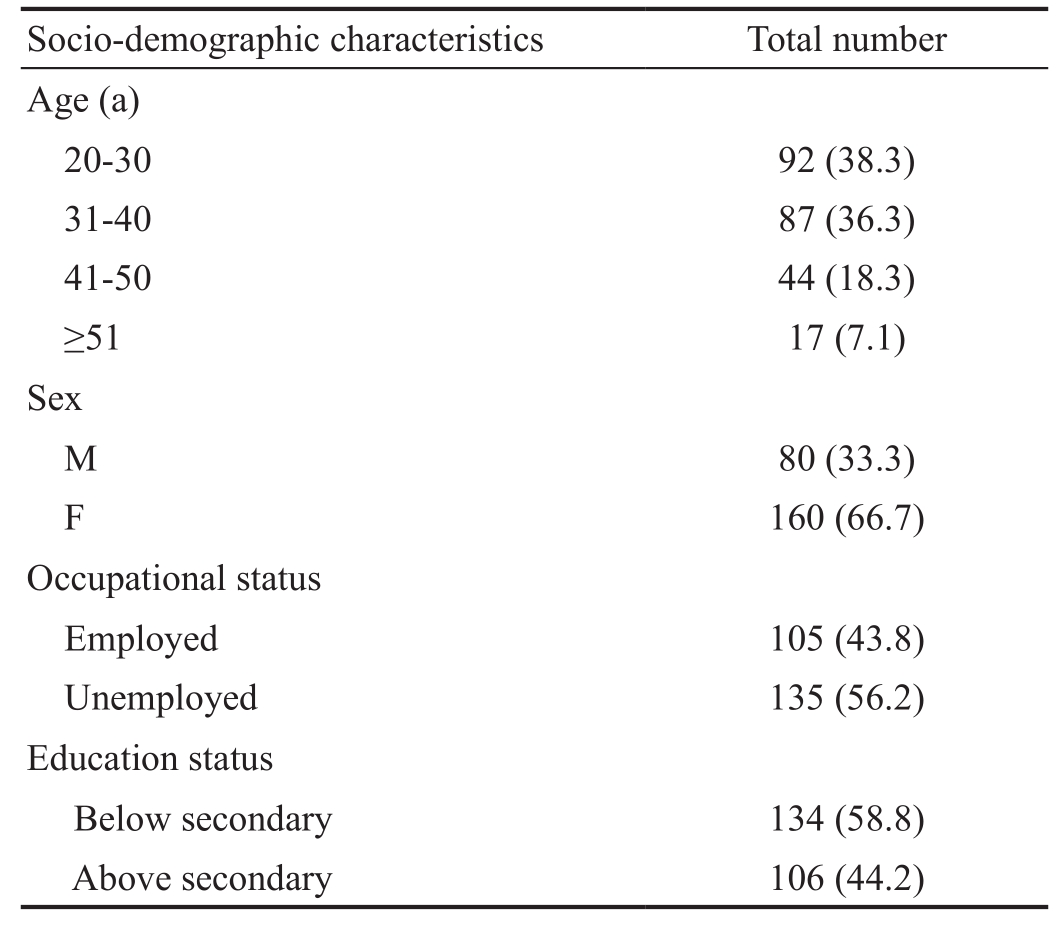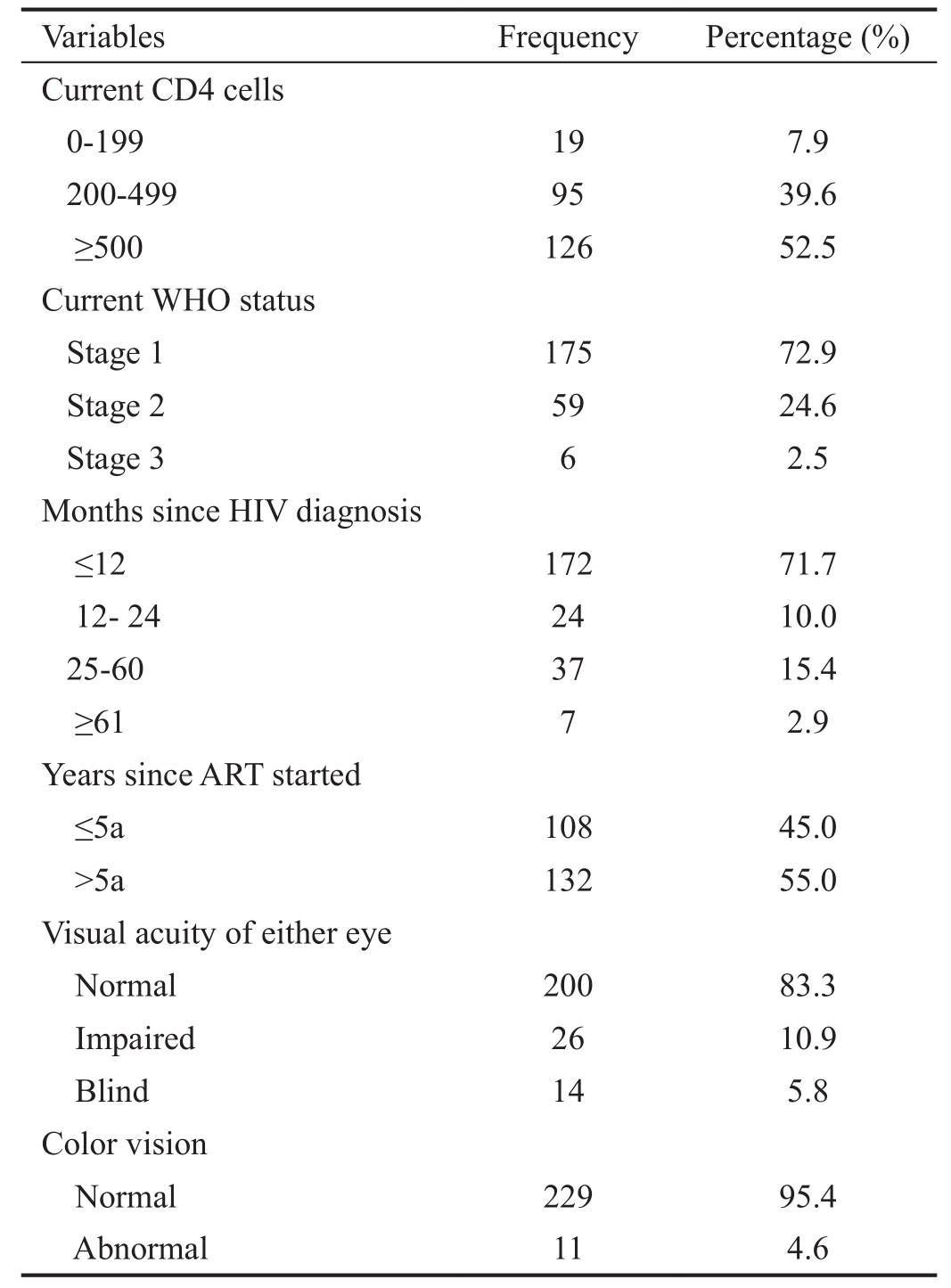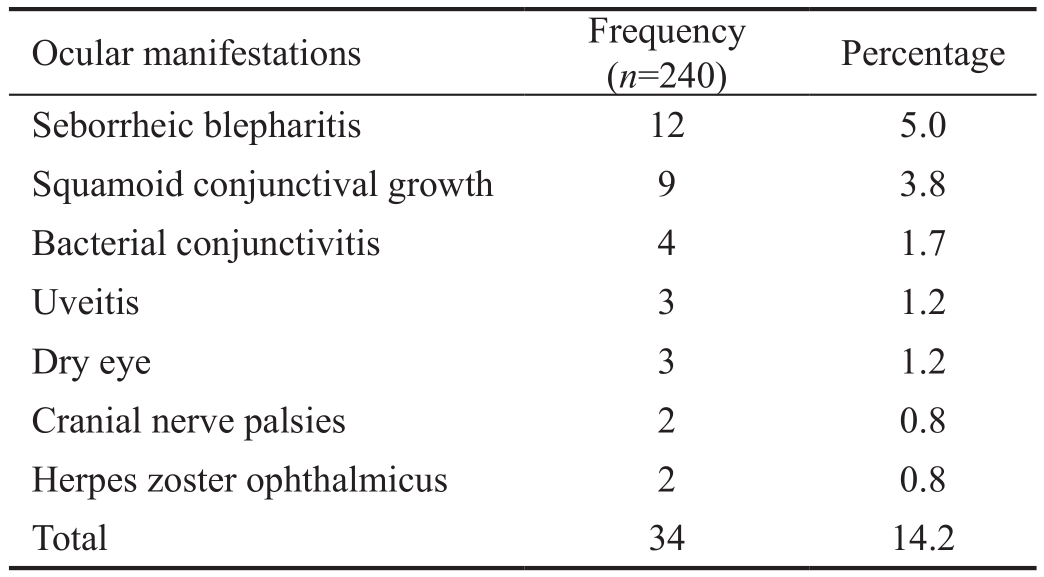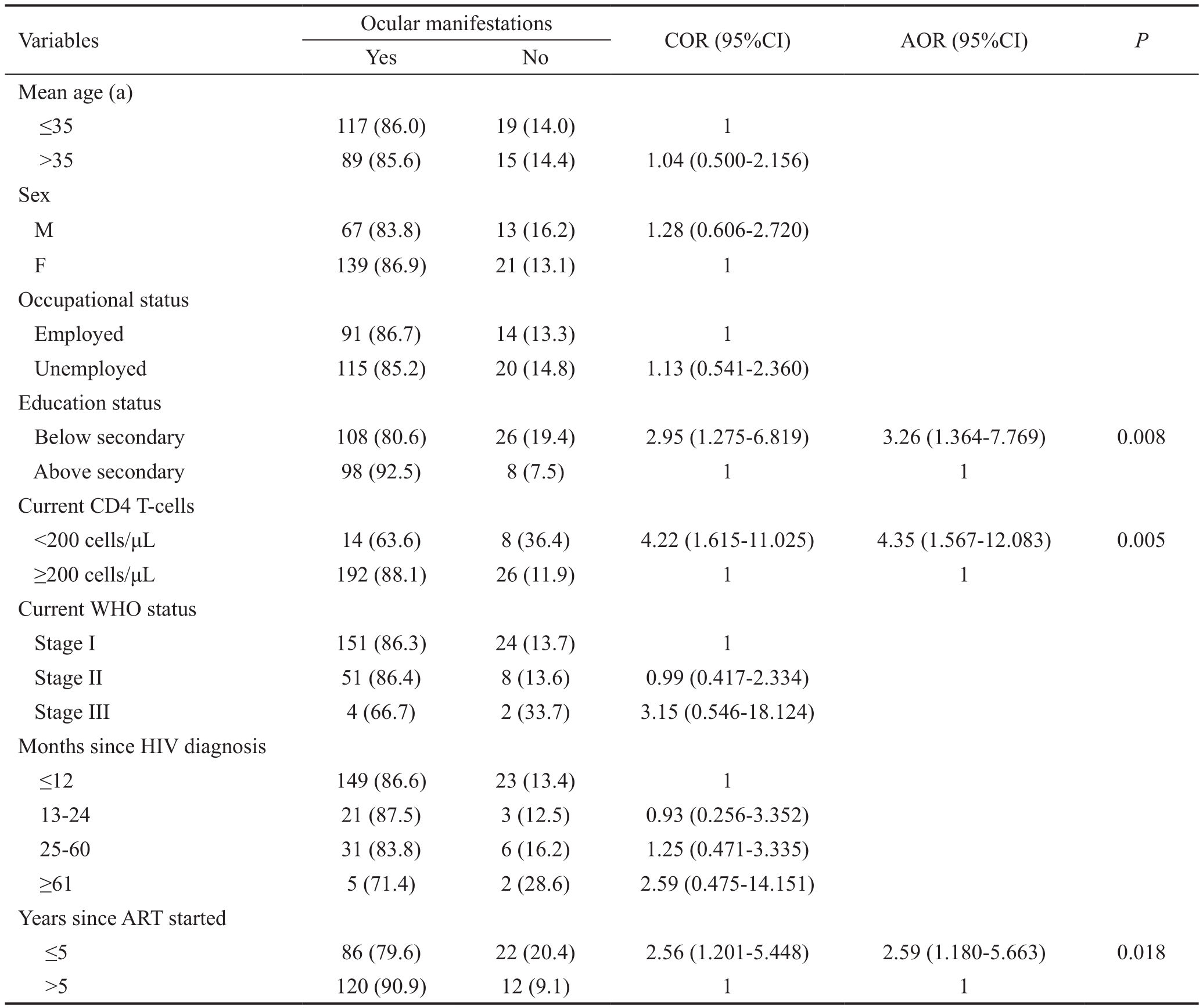INTRODUCTION
Highly active antiretroviral therapy (HAART) effectively restores the immune system and lowers the viral load in patients with human immunodef i ciency virus (HIV)/acquired immunodeficiency syndrome (AIDS)[1]. With the widespread introduction of HAART in Ethiopia, the pattern and prevalence of HIV/AIDS related ocular manifestation are expected to change. Ocular manifestation is very common and broad from a wide variety of complications in patients suffering from HIV/AIDS[2]. It involves any part of the eye from the adnexa and anterior segment to posterior segment, including orbital and the optic nerve[3]. The causes of HIV related ocular disorders may be opportunistic infections (OIs), vascular abnormalities,neoplasm, and drug induced and neuro-ophthalmic lesions.Among them, OIs are the major cause of morbidity and the most devastating ocular disorder in people with AIDS[4-5].
Although, HAART reduced the risk of OIs in HIV/AIDS patients[2], patients have started to live longer and new pattern of ophthalmic AIDS has emerged. Of them, immune recovery uveitis (IRU), cystoid macula edema (CME) and newer manifestations of known diseases such as cytomegalovirus(CMV), neovascularization or retinal detachment and ocular lesions due to drug-related reactions have been considered as a frequent visual threatening condition in the HAART era[2,6].
Studies have shown that, there has been a dramatic change in the pattern and prevalence of HIV related ocular manifestation from region to region as well as between the pre- and post-HAART era[7-8]. The prevalence is more predominant in Sub-Saharan Africa (SSA), where an absolute majority of HIV/AIDS patients lives. In spite of this, reports have suggested that infection-related retinitis is not common in SSA as compared to industrialized countries and South Asia[4]. In the pre-HAART era, CMV retinitis was the most common HIV associated ocular manifestation, occurring in 80% of patients.In the HAART era, the incidence of CMV retinitis has been suggested to decline to less than 40%. However, after the initiation of HAART, a relapse of CMV retinitis as vitritis has been reported[6]. In Ethiopia the occurrence of ocular manifestation in general has decreased from 60% in the pre-HAART era[9] to less than 25.7% in the HAART era[10-12]. Retinal microvaculopathy, keratoconjunctivitis sicca, conjunctival squamous cell carcinoma, uveitis, ophthalmic herpes zoster,seborrheic blepharitis, and Molluscum contagiosum were the most common ocular manifestations reported in the HAART era[10-12]. History of eye problem, WHO stage 3 and 4, CD4 cell count and low duration of antiretroviral therapy (ART) were some of the predictors of HIV related ocular manifestation described in literature[12].
Knowledge concerning the impact of HAART on ocular manifestation in HIV/AIDS patients is important as long as ocular manifestation may be the cause of visual impairment or blindness, which seriously damages the quality of life for patients living with HIV/AIDS[13]. In developing countries where there is a lack of effective treatment, test facilities and experience to diagnose opportunistic infection; the burden of ocular manifestation is very high. Hence, to ensure the optimal care to HIV/AIDS patients receiving HAART, it is important to know the patterns of ocular manifestation in a particular environment. Therefore, the purpose of this study was to evaluate pattern of ocular manifestation and associated factors of HIV/AIDS patients on HAART in Hawassa University Referral Hospital.
SUBJECTS AND METHODS
Study Design, Area and Period A cross sectional study was conducted in Hawassa University Referral Hospital from January 2014 to April 2015. The hospital is a tertiary level teaching Hospital that provides health services to over six million inhabitants in Southern Ethiopia and is located 275 km South from the capital city, Addis Ababa. HIV-infected patients monitor their disease status in the ART clinic of the hospital. Clinical and immunological assessments (CD4+ cell count) at enrolment and at three-monthly follow-up visits are taken to determine eligibility of patients for ART. Those who start receiving ART are monitored on a monthly basis until they show good treatment adherence, and on three-monthly basis, thereafter. There were 5022 adult HIV-infected people attending the ART clinic; of which, 3019 were taking ART during the study period. However, these patients are not routinely screened for ocular manifestation and only those with clinical indications of the disease are tested. Therefore, it is in this clinic with its large patient turnover that this research was carried out.
Subjects A total of 248 ART patients who have taken HAART for at least 2mo were recruited irrespective of; ophthalmic symptoms, WHO status or CD4 count, using systematic random sampling technique. Code number was written with special mark on their medical chart to avoid duplication.However, patients with additional medical problems like diabetes mellitus, hypertension and ocular trauma, not willing to give informed consent and age less than 18y were excluded.
Data Collection Procedure Socio-demographic data were collected using a standard questionnaire and medical records of ART patients were used to obtain information on WHO clinical stage, CD4 cell count, duration of HIV and HAART in the ART clinic. CD4+ cell counts within three months before data collection were taken as a current CD4+ cell count. After completing socio-demographic and clinical data, patients were referred to the eye clinic for ophthalmic examination.
Ophthalmic Examinations The ocular examinations were done by an ophthalmologist using the following format: best corrected visual acuity (logMAR chart), color vision test(Ishihara test), anterior segment examination (slit lamp) and dilated fundus examination with tropicamide 1% (90 D slit lamp biomicroscopy and 20 D binocular indirect fundoscopy).Laboratory investigations were done for some patients whenever necessary. While, histopathologic studies were not done due to lack of facility during the study period.
Def i nition of Terms Squamoid type conjunctival growth was clinically defined as a suspicious conjunctival mass on slit lamp examination; visual impairment was def i ned as presenting visual acuity (VA) of less than 6/18 (0.3 logMAR), but equal to or better than 3/60 (0.05), and blindness was defined as presenting VA of 3/60 or worse, in the better eye[12,14]; HAART based on the guideline, common ART regimens in Ethiopia are: AZT-3TC-NVP, AZT-3TC-EFV, d4T-3TC-NVP, d4T-3TCEFV,TDF-3TC-EFV or TDF-3TC-NVP[15].
Ethical Consideration Ethical approval was obtained from the Institutional Review Board (IRB), of College of Medicine and Health Sciences, Hawassa University. Permission was taken from the hospital administration. Informed and written consents were obtained from the study subjects. Patient records/information was anonymized and de-identified prior to analysis. Those patients who needed further refraction and surgical intervention were done by optometrist and ophthalmologist respectively. Health education and medical therapy were given whenever necessary during data collection.
Statistical Analysis Data were encoded, entered and analysed using SPSS version 20 software. Descriptive statistical methods, bivariate analysis and multivariate logistic regression analysis were conducted. Odds ratio with its corresponding 95% confidence interval was used as the measure of the degree of association of independent variables with ocular manifestation. A P-value less than 0.05 was considered as signif i cant.
RESULTS
Study Subjects A total of 248 randomly selected HIV- infected patients receiving HAART were approached for the study.Of these, 8 patients failed to attend ophthalmic examination resulting in incomplete data. As a result a complete data were collected from 240 patients (480 eyes) and all of the patients were residents of Hawassa town. Female accounted for 66.6%of the study participants, with male to female ratio of 1:2. Their mean age was 35.4y [standard deviation (SD), 9.5; range 20-65y] and substantial numbers (38.3%) were in the age category of 20-30y. The majority (56.2%) of study participants were unemployed and had secondary school education and above (44.2%) but, only 14.6% had no formal education (Table 1).Clinical Profile of HIV/AIDS Patients Receiving HAART Of the 240 patients, the majority (55%) of them had received HAART at least fi ve years with the mean duration of 62.5mo(range 7-106mo) and a higher proportion of participants(71.7%) had started HAART within a year since HIV diagnosed. Their mean CD4+ cell count was 525 cells/μL[interquartile range (IQR), 362.5-696.5 cells/μL; range,41-1431 cells/μL] and 126 (52.5%) had CD4+ cell count of greater or equal to 500 cells/μL. None of the study participants were on WHO clinical stage IV, while only 6 (2.5%) of participants were on WHO clinical stage III at the time of the study period. The prevalence of visual impairment and blindness in the better eye was 10.9% and 5.8% respectively.In addition, most of the study participants (95.8%) had normal color vision (Table 2).
Prevalence and Pattern of HIV/AIDS Related Ocular Manifestation Of the study participants examined by an ophthalmologist, 14.2% of HIV/AIDS patients on HAART had ocular manifestation. Of these, 5% were seborrheic blepharitis,followed by squamoid conjunctival growth (3.8%) and bacterial conjunctivitis (1.7%) (Table 3).
The Visual Status of HIV/AIDS Patients Receiving HAART Visual acuity was normal in 90.1% of the patients, 7.2% had visual impairment and 2.7% were found to be bilaterally blind.Five of the bilaterally blind patients were due to cataract (Table 4).
Factors Associated with HIV/AIDS Related Ocular Manifestation Factors associated with HIV/ADS related ocular manifestation is described in Table 5. In bivariate logistic regression analysis, CD4+ cell count, duration since ART started, and level of education had signif i cant association with the presence of HIV/AIDS related ocular manifestation among patients receiving HAART. Ocular manifestationdid not vary by mean age, sex, occupation, WHO stage and duration of commencing ART since HIV diagnosis.
Table 1 Socio-demographic characteristics of HIV/AIDS patients receiving HAART in Hawassa University Referral Hospital,2015 n (%)

Table 2 Clinical prof i le of HIV/AIDS patients receiving HAART in Hawassa University Referral Hospital, 2015

CD: Cluster of differentiation; HIV: Human immunodeficiency virus; ART: Antiretroviral therapy.
In multivariate logistic regression analysis, the odds of having ocular manifestation was 4.3 times for patients with CD4+cells count less than 200 cells/μL compared to patients with aCD4+ cell count of ≥200 cells/μL [AOR=4.35; 95%CI=1.567-12.083; P=0.005]. Patients who had received HAART less than fi ve years were 2.6 times more likely to develop ocular manifestation than those who received HAART greater than five years [AOR=2.59; 95%CI=1.180-5.663; P=0.018].Moreover, the education level of participants also inf l uenced the rate of ocular manifestation where those with below secondary school level education [AOR=3.26; 95%CI=1.364-7.769; P=0.008] had higher odds of ocular manifestation compared with those having at least a secondary school education (Table 5).
Table 3 Prevalence and pattern of HIV/AIDS related ocular manifestation on patients receiving HAART in Hawassa University Referral Hospital, 2015

Table 4 The visual status of HIV/AIDS patients receiving HAART in Hawassa University Referral Hospital, 2015 n (%)

CF: Counting fi nger.
DISCUSSION
In this study, the majority of the HIV/AIDS patients on HAART (97.5%) were in WHO stages I and II and had high mean CD4+ cell count (525 cells/μL). The mean duration of HAART therapy was 62.5mo. About one out of seven patients had HIV/AIDS related ocular manifestation. The most common ocular manifestations were seborrheic blepharitis(5%) and squamoid conjunctival growth (3%). The rate of ocular manifestation was significantly higher among participants who had CD4+ cells count <200 cells/μL, received HAART less than fi ve years and had below secondary school level education.
The prevalence of HIV related ocular manifestation in this study was 14.2%. This fi nding was lower than recent studies conducted in Ethiopia: Jimma in 2009 (25.3%)[10], Gondar in 2010 (21.4%)[11] and Felege Hiwot Referral Hospital in 2013(25.7%)[12] and much lower than a study conducted in Gondar University Hospital one decade before (60%)[9]. The lower prevalence of ocular manifestation in our study might be attributed to long mean duration of taking HAART that might have a positive impact on clinical presentation of HIV related diseases and immunologic response (CD4+ cell count) and the difference in type of study participants in Gondar[9] which was conducted on pre-HAART patients, who were admitted to hospital with a medical problem and came to the eye clinic with ocular complaint in contrast to our study participants which were selected randomly in ART clinic and received HAART a minimum of 2mo.
The most frequent ocular manifestation in our study was adnexal manifestation which includes seborrheic blepharitis(5%), squamoid conjunctival growth (3.8%) and bacterial conjunctivitis (1.7%) and herpes zoster ophthalmicus (0.8%).This is in agreement with previous studies in Ethiopia[10-12] and Tanzania[16]. In contrast, a study conducted in India described only a few cases with problems involving the conjunctiva and eyelid[17-18]. This, perhaps, is due to difference in educational status that may have indirect effect on hygiene and the majority of recruited cases in this study were on WHO stage I-II and CD4+ cell count ≥200 cells/μL suggested to have ocular manifestation such as blepharitis, dry eyes, bacterial and follicular conjunctivitis, Herpes Zoster Ophthalmicus (HZO),herpes simplex, HIV retinopathy, allergic conjunctivitis,intermediate uveitis, retinal vasculitis, molluscum contagiosum,Kaposi's sarcoma and optic neuropathy[19-20].
Although, recent studies had shown that in the HAART era clinical entities like immune recovery uveitis have appeared as a cause of concern related to blindness[21], only three cases were clinically diagnosed as uveitis in our study. Of the three uveitis cases, one patient had a previous history of systemic tuberculosis (TB), while the cause of the uveitis was not established in the remaining two patients. However, there were no any cases of cytomegalovirus retinitis (CMVR), HIV retinopathy, microvasculopathy (RM), keratoconjunctivitis sicca, molluscum contagiosum and Kaposi's sarcoma reported in our study discordant with the previous studies in Ethiopia[10-12]. The possible reason for no reports of these manifestations in our study may be due to difference in study subjects. In our study only patients on HAART were included,while a study in Assefa et al[9] and Bekele et al[10] included 100% and 49.7% pre-HAART cases, respectively.
In this study, the mean CD4+ cells count of patients with ocular manifestation (496.32 cells/μL) was lower than the mean CD4+ cell count of patients without ocular manifestation(530.67 cells/μL). It was also found that those with a CD4+cell count of <200 cells/μL were more than four times more likely to have HIV related ocular manifestation. These fi ndings are in agreement with other studies conducted in Felege Hiwot Referral Hospital[12] and India[22]. Similarly, in our study,patients who had received HAART for less than five years were 2.5 times more likely to develop ocular manifestationcompared to their counterparts because long term use of HAART reduce plasma HIV RNA to permanently low levels,reduction in the viral load and a rise in CD4 cell counts and boosting the immunity status of patients which decrease the occurrence of opportunistic infection[23] concordant with study conducted elsewhere[10,12]. However, there was no significant association between WHO stage and ocular manifestation in our study in line with a study conducted in Felege Hiwot Referral Hospital[12].
Table 5 Regression analysis for factors associated with ocular manifestation among HIV/AIDS patients receiving HAART in Hawassa University Referral Hospital, 2015 n (%)

CD: Cluster of differentiation; HIV: Human immunodeficiency virus; ART: Antiretroviral therapy; COR: Crude odds ratio; AOR:Adjusted odds ratio.
Previous studies had shown the preponderance of ocular manifestation among men and age >35y[10,22], though those studies had no strong statistical power to be able to detect the rate difference. In contrast, our finding showed no statistical signif i cant difference in sex and age. In this study, patients who had below secondary school education had higher odds ocular manifestation as compared to having at least a secondary school education. Unlike our fi nding, a study in Felege Hiwot referral hospital[12] had reported ocular manifestation, had no statistical significant difference with level of education. This might be due to our study patients have adnexal manifestation which might be due to poor personal hygiene.
This study has some limitations in light of which results need be interpreted. First, there was no control group who are ART naïve to compare the change in prevalence and pattern between pre- and post HAART era. Second, due to logistic and facility problems histopatologic studies were not done for those who manifest squamoid conjunctival growth which confuse with pterygium. However, before conclusion as squamoid conjunctival growth consistent result have been observed by another ophthalmologist.
In conclusion, HAART may be the cause for the decline in the prevalence of ocular manifestation in HIV/AIDS patients in the study area. The most frequent ocular manifestation was seborrheic blepharitis and squamoid conjunctival growth. The prevalence of visual impairment and blindness in the better eye was 10.9% and 5.8% respectively. Ocular manifestation was significantly associated with patients who had, CD4+count of <200 cells/μL, with low duration of HAART and below secondary school education. Therefore, ophthalmologic screening of HIV/AIDS patients, especially those with CD4 counts of <200 cells/μL and in the fi rst fi ve years of HAART follow-up is recommended to reduce visual impairment or blindness.
ACKNOWLEDGEMENTS
We are grateful to the staff of the ART Clinic and Ophthalmology Unit at Hawassa University Referral Hospital for their assistance during data collection. We also acknowledge the Hawassa University for fi nancial support.
Conflicts of Interest: Amsalu A, None; Desta K, None;Nigussie D, None; Delelegne D, None.
REFERENCES
1 Arora R, Goyal JL, Mina M, Goel M. Impact of highly active antiretroviral therapy (HAART) on ophthalmic manifestations in aids patients. AIOC, proceedings 2009.
2 Sudharshan S, Kaleemunnisha S, Ashraf Banu A, Shrikrishna S, George AE, Rajesh Babu B, Devaleenal Bella, Kumarasamy N, Biswas J. Ocular lesions in 1,000 consecutive HIV-positive patients in India: a long-term study. J Ophthalmic Inf l amm Infect 2013;3(1):2.
3 Mehta R, Mehta P, Mohanty L, Bedi N, Punjabi S, Jain R, Nagar CK.Changing pattern of ophthalmic manifestation in AIDS patients in post HAART era. Int J Adv Health Sci 2014;1(5):15-22.
4 Mowatt L. Ophthalmic manifestations of HIV in the highly active antiretroviral therapy era. West Indian Med J 2013;62(4):305-312.
5 Valathuru V, Kambar C, Pisipati R, Desai S. Ocular manifestations in HIV/AIDS-prevalence in South India. Ophthalmology Research: An International Journal 2014;2(3):165-176.
6 Tan SY, Liu SW, SB J. HIV/AIDS and ocular complications. Int J Ophthalmol 2009;2(2):95-105.
7 Venkatesh KK, Biswas J, Kumarasamy N. Impact of highly active antiretroviral therapy on ophthalmic manifestations in human immunodef i ciency virus/acquired immune def i ciency syndrome. Indian J Ophthalmol 2008;56(5):391-393.
8 Accorinti M, Pirraglia MP, Corradi R, Corsi C, Fabiani C, Pivetti-Pezzi P. Changing patterns of ocular manifestations in HIV seropositive patients treated with HAART. Eur J Ophthalmol 2006;16(5):728-732.
9 Assefa Y, Yohannes A, MelesiA. Ocular manisestations of HIV/AIDS patients in Gondar University Hospital, Northwest Ethiopia. Ethiopian Journal of Health Development 2009;20(3):166-169.
10 Bekele S, Gelaw Y, Tessema F. Ocular manifestation of HIV/AIDS and correlation with CD4+ cells count among adult HIV/AIDS patients in Jimma town, Ethiopia: a cross sectional study. BMC Ophthalmology 2013;13:20.
11 Amare B, Admassu F, Assefa Y, Moges B, Ali J, Kassu A. Pattern of ocular manifestation of HIV/AIDS among patients on HAART in ART Clinic of Gondar University Hospital, Northwest Ethiopia. J Clinic Experiment Ophthalmol 2011;2:192.
12 Sharew G, Azage M. Predictors of HIV/AIDS related ocular manifestations among HIV/AIDS Patients in Felege Hiwot Referral Hospital, Northwest Ethiopia. J Ophthalmol 2015;2015:965627.
13 Murthy G. The socioeconomic impact of human immunodeficiency virus/acquired immune def i ciency syndrome in India and its relevance to eye care. Indian J Ophthalmol 2008;56(5):395-397.
14 Katibeh M, Pakravan M, Yaseri M, Pakbin M, Soleimanizad R.Prevalence and causes of visual impairment and blindness in central Iran;The Yazd Eye Study. J Ophthalmic Vis Res 2015;10(3):279-285.
15 DACA: Standard treatment guideline for primary hospitals. Addis Ababa, Ethiopia: DACA. 2010.
16 Sahoo S. HIV- and AIDS-related ocular manifestations in Tanzanian patients. Malaysian J Med Sci 2010;17(1):12-16.
17 Shah SU, Kerkar SP, Pazare AR. Evaluation of ocular manifestations and blindness in HIV/AIDS patients on HAART in a tertiary care hospital in Western India. Br J Ophthalmol 2009;93(1):88-90.
18 Gharai S, Venkatesh P, Garg S, Sharma SK, Vohra R. Ophthalmic manifestations of HIV infections in India in the era of HAART: analysis of 100 consecutive patients evaluated at a tertiary eye care center in India.Ophthalmic Epidemiol 2008;15(4):264-271.
19 World Health Organization. Revised WHO Clinical Staging of HIV/AIDS [Internet]. Geneva: World Health Organization. Accessed on Oct 6,2009. Available at www.who.int/hiv/pub/guidelines/clinicalstaging.pdf.
20 International Council of Ophthalmology: Ocular Manifestation of HIV Infection [Internet]. San Francisco: International Council of Ophthalmology. Accessed on Oct 6, 2009. Available at http://www.icoph.org/med/ppt/hiv.pdf.
21 Goldberg DE, Smithen LM, Angelilli A, Freeman WR. HIV-associated retinopathy in the HAART era. Retina 2005;25(5):633-649.
22 Aratee P, Vinay K, Pallavi B. Ocular manifestations in HIV positive patients in Western India 2009. www.aios.org/proceed08/papers/MIS/Mis09.
23 Kestelyn PG, Cunningham ET Jr. HIV/AIDS and blindness. Bull World Health Organ 2001;79(3):208-213.